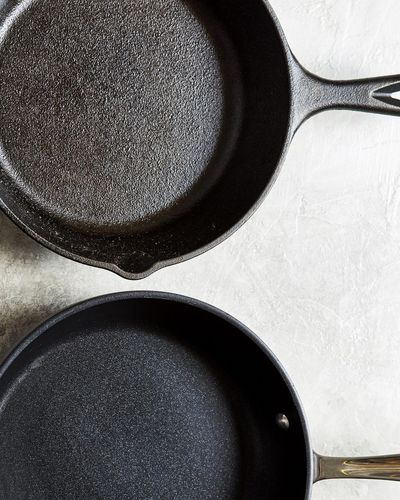Cast-iron vs. nonstick skillets: How to choose the right pan

Cast iron is often called the original nonstick pan. And it makes sense. Well-seasoned cast-iron skillets have a naturally formed coating that is created when fats are heated to a certain point that causes them to reorganize into something resembling a plastic coating and bond to the metal.
For centuries, cast-iron was the only nonstick there was. But then the 20th century saw the introduction of commercially manufactured nonstick skillets, which rely on a chemical-based coating. Now, according to Cook’s Illustrated, “70 percent of the skillets sold in the United States are nonstick.” While cast iron’s coating improves with age and is easily repaired, you can expect a well-cared-for nonstick skillet to last a few years (your mileage may vary) and then you must replace it.
Cast-iron and nonstick pans can do a lot of the same things – but that doesn’t mean they’re always interchangeable. Here’s what you need to think about when you’re deciding which skillet to pull out.
Heat. One of the great things about cast-iron skillets is that you can crank up the heat under them. On the other hand, nonstick skillets are best used at medium heat, or medium-high at the max. It’s not just a performance issue. At very high temperatures (500 to 600 degrees), the chemicals used in nonstick coatings can begin to degrade and be released. The good news is that cooking at the recommended heat with food in the skillet won’t let you get even close to that level. Check out both Consumer Reports and Good Housekeeping for articles on the science behind why modern nonstick skillets are generally deemed safe. (There are plenty of home cooks who prefer not to take any risk with those chemicals – I’ve heard from some.)
Browning. In addition to having a limit on their heat, nonstick skillets don’t actually conduct heat as efficiently because of their coating, Good Housekeeping explains. For those reasons, you’ll want to turn to cast iron when it’s time to sear meat. You’ll get great color and, therefore, flavor. In a similar vein, cast iron is ideal for deep-frying.
Stove top to oven potential. No question, the ability to move cast iron from the stove top to the oven, as with a braise or frittata, is a huge advantage. Many nonstick skillets today are oven-safe as well, though not all of them, especially if they include elements such as a silicone handle that further limit how hot the oven can be. You shouldn’t broil with a nonstick skillet, either.
Baking. Cast iron’s heat retention is attractive when it comes time to baking. Corn bread, pies and skillet cookies will all sport a deeply colored, crisp crust after baking in cast iron. Cast-iron skillets often have angled instead of rounded seams between the sides and bottom so that you get a sharper, stabler corner on those baked goods.
Acidic foods. You can cook acidic foods such as tomato sauce in a well-seasoned cast-iron skillet, though Cook’s suggests limiting the time to half an hour and then removing it right away. On this count, nonstick (or enameled cast-iron or stainless steel) has the advantage if you’re unsure about your seasoning, or you need a long cook time.
Preventing sticking. Of course, the goal with both types of skillets is to have your food not stick. That being said, there are certain foods that are a safer bet in a nonstick skillet. For Sandy Patterson, the chef de cuisine at LEO MKT at Georgetown University and a former instructor at the late L’Academie de Cuisine, those foods are eggs and fish, especially more delicate varieties.
Cook’s recommends using the nonstick skillet “for recipes with sugary sauces that scorch easily, such as stir-fries; and for pan-frying breaded foods so that the coating sticks to the food and not to the pan. Nonstick skillets are also our go-to for pancakes, because they don’t let bits of butter and batter burn onto their surfaces,” compared to stainless-steel skillets anyway.
Another advantage of saving your nonstick skillet for a relatively narrow range of food is that the limited usage will extend its life, Patterson says.
Sarah Carey, editorial director of food and entertaining for Martha Stewart Living, notes that cast-iron can more stubbornly retain odors, which can be problematic for whatever you plan to cook next. She cites bacon and fish as prime culprits.
Your ultimate choice may also reflect your confidence as a cook and in your cast-iron seasoning, Carey says. If you’re more worried about a potential cooking flop, it’s OK to defer to nonstick.